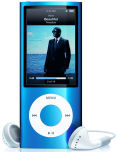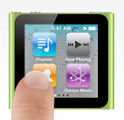For a company known for its clearness and certainty of vision, Apple has shown an amazing variety of takes for the different versions of the product it calls the iPod nano.
After all, the iPod shuffle is clearly the minimalist clip-on music player without a display, while the iPod touch is clearly the entry to full-fledged iOS devices (see previous post).
But what kind of player is in between basic and iOS? Should it play video, as well as music? Should it have a camera for photos or videos? Should it be a multi-function device, but for what, without the Apple iTunes and App stores? Does it need a touch interface, or just a click wheel? And is the screen just for choosing music, or for more sophisticated functions?
Apple has answered yes to all of these alternatives over the multiple generations of the nano, with its last full refresh in 2010 (see earlier post). And now it has changed again with the announcement of the nano generation 7.
 The original nanos from 2005 and 2006 were click-wheel music players, with a simple 1.5 inch display for choosing music, plus built-in games, calendar, contacts, and notes.
The original nanos from 2005 and 2006 were click-wheel music players, with a simple 1.5 inch display for choosing music, plus built-in games, calendar, contacts, and notes.
As memory sizes were expanding into multiple GB, players really needed go beyond the shuffle to add a display so that you could reasonably access thousands of songs in a handhold device.
 With the nano generation 3 in 2007, Apple upgraded the nano to a full-fledged video player with a 2 inch color display with the same resolution as the iPod video. It also provided more advanced interface features like Cover Flow to flip through album covers.
With the nano generation 3 in 2007, Apple upgraded the nano to a full-fledged video player with a 2 inch color display with the same resolution as the iPod video. It also provided more advanced interface features like Cover Flow to flip through album covers.
With the emphasis on video, the screen stretched in landscape mode, so the overall look went from thin to wide.

But just a year later, as the iPhone added the App Store to become a customizable platform, the nano gen 4 shrunk back down to tall and narrow, with a smaller 2 inch display.
The new theme was focused on an especially sleek and thin design for music and video playback.
 Then the nano gen 5 from 2009 kept the same design, but stepped back up even closer to iPhone/touch kind of capabilities as an almost-but-not-quite iOS device, keeping the narrow design but adding a slightly larger 2.2 inch display plus a video camera, microphone and speaker, FM radio, and pedometer.
Then the nano gen 5 from 2009 kept the same design, but stepped back up even closer to iPhone/touch kind of capabilities as an almost-but-not-quite iOS device, keeping the narrow design but adding a slightly larger 2.2 inch display plus a video camera, microphone and speaker, FM radio, and pedometer.
As a PDA type device, it also supported clocks, alarms, and stopwatch, and could sync contacts, calendars, and to-do lists with iTunes.
 But in 2010, Apple swung totally in the other direction, revamping the nano gen 6 as a shuffle-style music player, but trading in the control pad for a touch-screen display. The new design had the shuffle's rectangular shape, with a 1.54 inch display over the entire area.
But in 2010, Apple swung totally in the other direction, revamping the nano gen 6 as a shuffle-style music player, but trading in the control pad for a touch-screen display. The new design had the shuffle's rectangular shape, with a 1.54 inch display over the entire area.
The miniaturized nano also lost the camera, mic, and video playback, but kept the FM radio and pedometer. The refresh a year later further emphasized the fitness features.
 Which brings us to last week's announcement of the iPod nano generation 7, which jumps back into the widescreen media player world, following the example of the new iPod touch and iPhone 5 -- but with a custom interface still separate from the iOS world
Which brings us to last week's announcement of the iPod nano generation 7, which jumps back into the widescreen media player world, following the example of the new iPod touch and iPhone 5 -- but with a custom interface still separate from the iOS world
The 2.5 inch Multi-Touch display is smaller than the other 4" devices, and significantly lower resolution (432 x 240 vs. 1136 x 640). But it's now once again a serious photo viewer and video player.
The nano continues the FM radio and pedometer, but still omits a camera. But besides the display, the biggest addition is Bluetooth support to play your music wirelessly to headphones, speakers, and cars.
The result is viewable player in a thin and light design -- the "thinnest iPod ever" at 5.4 mm, and 3 x 1 1/2 inches. Apple reports that the battery supports up to 30 hours of music playback, and 3.5 hours of video.
The new iPod nano gen 7 is available for $149 with 16 GB of storage, in a profusion of colors -- pink, yellow, blue, green, purple, silver, and slate.
See my Apple iDevices Gallery for more details on the current -- and past -- Apple iOS devices, including the iPods, iPhones, and iPads, as well as product chronologies.
